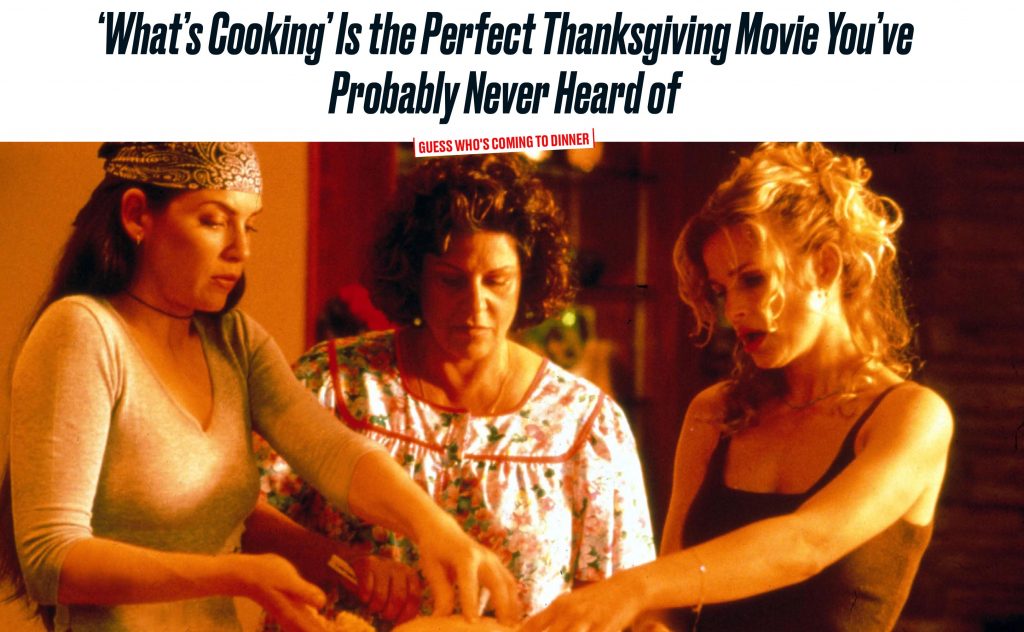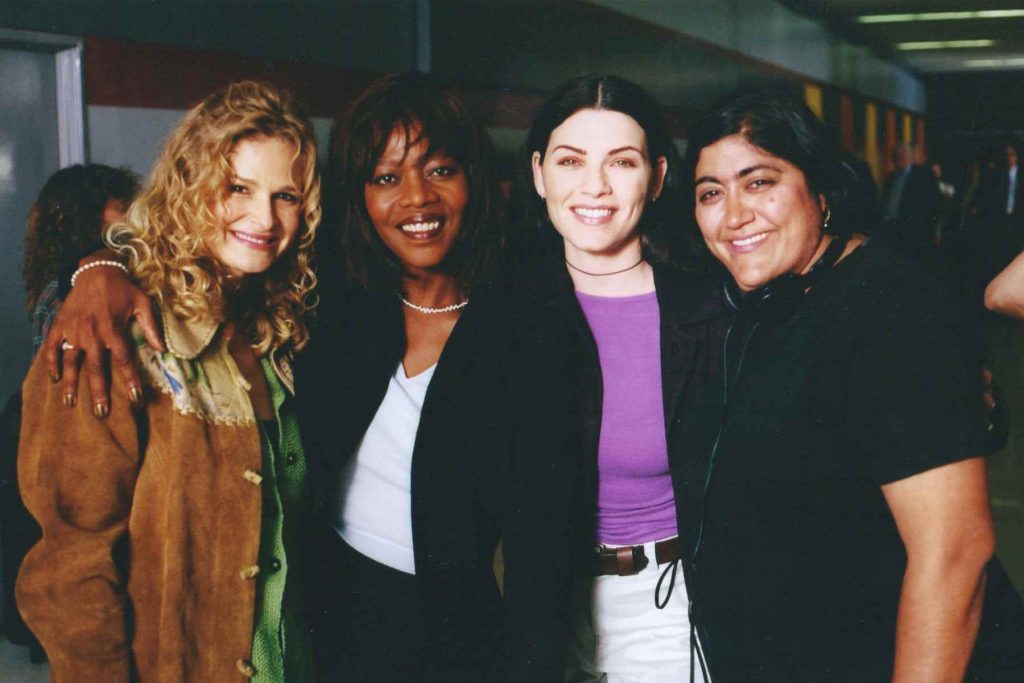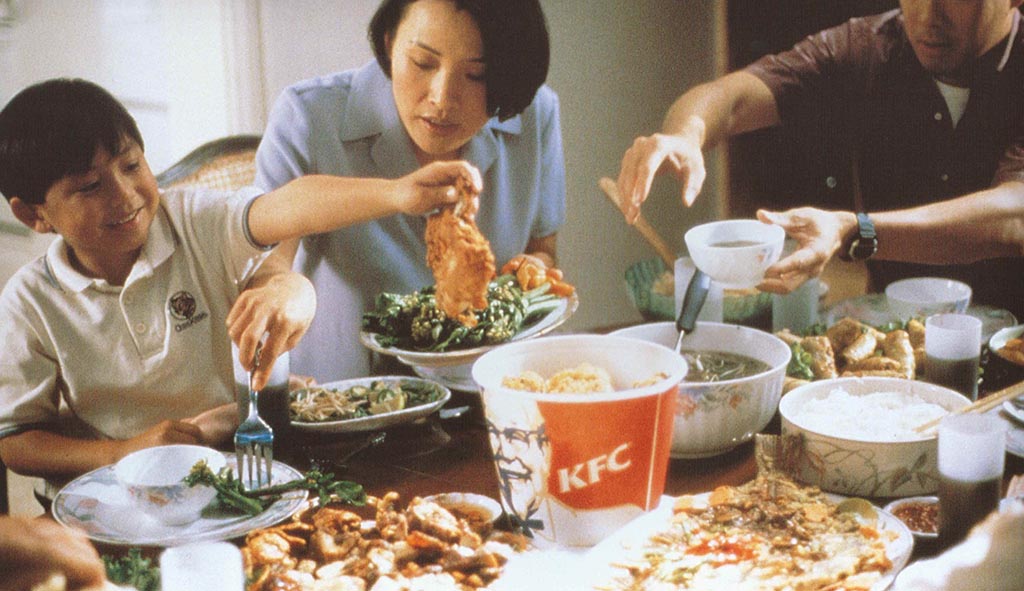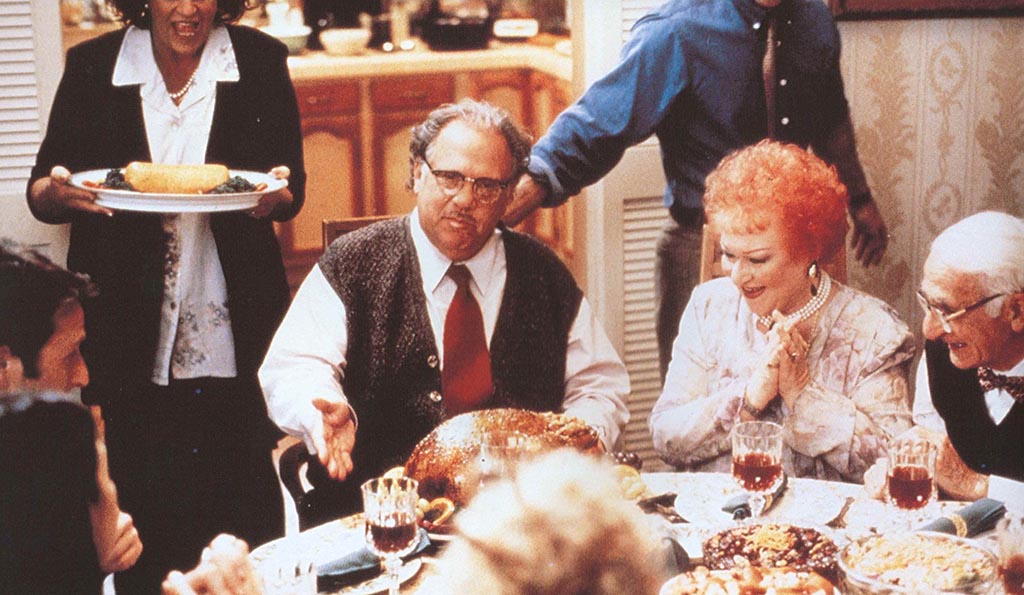

Jewish family quasi-closeting their lesbian daughter. A Vietnamese-American teenager being yelled at for having a condom while no one realizes her brother is hiding a gun in the house. A black Republican fighting with his son over affirmative action. A Latina mother sharing a table with her ex-husband who slept with her cousin.
These are not the Hallmark card images of Thanksgiving that are surprisingly, and often relentlessly, still packaged to Americans. But in 2000, What’s Cooking? interwove these four seemingly disparate family stories together into a sumptuous Thanksgiving feast of a film—one that serves up gỏi cuốn, kishkas, and empanadas along with its turkey. Now, two decades later, it remains the most authentic, charming, and hands-down most satisfying Thanksgiving movie.
Ironically, not being American may be the very key to creating a film that accurately captures the most quintessentially American holiday without getting weighed down in saccharine or schmaltz. Much like Thanksgiving itself, What’s Cooking? is a British brainchild. The movie is directed and co-written by Gurinder Chadha, the British Indian filmmaker behind the globally beloved Bend It Like Beckham and last year’s jubilant, Bruce Springsteen-fueled Blinded by the Light.
“Everyone will bang on about Bend It Like Beckham because they can see it’s about an Indian girl and all that, but when it’s this film and I mention it, it’s like ‘I’ve seen that movie! You made that movie? It’s so American!” Chadha told The Daily Beast. “There’s the expectation of what a person like me would make as a movie, and I think what What’s Cooking? does is sort of throw that out.”
Chadha was inspired to build a movie around Thanksgiving after coming to Los Angeles and spending the holiday with her husband Paul Mayeda Berges, her co-writer on What’s Cooking? Berges, who grew up in L.A. and whose parents divorced when he was very young, would split Thanksgiving. First, they would go to his father’s for a meal, which Chadha described as a “fancy-shmancy Thanksgiving.” Then, they would spend dinner with Berges’ Japanese-American mother, whose Thanksgiving “was always a big old turkey and mash” but also “sushi and ribs and all this other food on the table.”
The director loved how Thanksgiving could be universally celebrated but in wildly different ways that reflected the diverse communities in America. “My work up ’til that point in Britain had always been about opening up this concept of Britishness,” she said. “I just took that debate to America to decide, how do you define the American family?”

She built the movie around four Los Angeles families of different racial and ethnic backgrounds celebrating—and, to a certain degree, suffering through—Thanksgiving in ways that are both distinct and remarkably similar. Or, as Chadha put it, “What’s going on in each family could be happening in any of the families. Nothing culturally specifically, it’s just shit happens in all families.”
The African American Williams family is headed by Audrey (Alfre Woodard), who is left high and dry with a mother-in-law whose disapproval of her modern menu seems like a larger indictment of her as a wife and mother, while her Colin Powell-loving Republican husband, Ronald (Dennis Haysbert), ditches the family to tend to his boss, the governor of California. In the Vietnamese American Nguyen family, Trinh (Joan Chen) erupts in anger and despair at the prospect that her teenage daughter Jenny (Kristy Wu) might be having sex and her larger fear that her children are becoming American in the worst, most disrespectful way. The Latino Avila family is led by Elizabeth (Mercedes Ruehl), an elementary school teacher and newly single mother. But her husband, Javier (Victor Rivers), who walked out on her, has pulled off an invite to the Thanksgiving dinner with remarkable chutzpah. In the Jewish Seelig family, mom Bea (Lainie Kazan) and dad Herb (Maury Chaykin) lie awake at night, alternating between wondering if their daughter Rachel (Kyra Sedgwick) is a lesbian because they sent her to “that kibbutz… with all those girls” and worrying what will happen if her partner Carla (Julianna Margulies) breaks up with her, since their house is in Carla’s name.
“When I read the script, I thought, ‘Right, this is America—what is everyone’s household like at Thanksgiving because we are a melting pot of different cultures?” Julianna Margulies told The Daily Beast. Plus, she said, “My God, of all the people to be in love with, Kyra Sedgwick was the pot of gold right there!”
For an independent movie, What’s Cooking? was punching well above its weight in terms of star power, especially when it came to the women leading these families. But its actors are only one part of the onscreen performance. “The food told its own story. Everyone had yams but everyone had them differently; everyone had turkey but everyone did it differently. Each element of food was a character and supported the characters,” said Chadha.
Sedgwick recalled to The Daily Beast “how meticulous Gurinder was about those cooking scenes. I had to be taught how to pinch the pie and everything.” Margulies, on the other hand, remembered a turkey hangover. “When you’re acting in a movie about food, the first day it’s really fun and then you realize, ‘Oh my God, for continuity I took a bite’ and every time, you have to take that same bite,” she said, laughing. “And you know, four days later, the food is still sitting there.”
In perhaps the greatest food scene in all of film, What’s Cooking? playfully cuts between the different ways each family adds accoutrements to their Thanksgiving meal—dotting sweet potatoes with marshmallows and maraschino cherries (the Seeligs), making tamales and slicing fresh onions, tomatoes, and limes (the Avilas), tightly wrapping up shrimp and lettuce into the perfect spring roll (the Nguyens), slicing scallions to top off a Martha Stewart-esque scalloped potatoes dish (the Williams)—all while the very Californian song “Wipe Out“ plays. Even better, there are different instrumentations of “Wipe Out,” alternating between the classic version and ones that take on each of the families’ musical cultures. This medley of food and music embodies a key message of What’s Cooking?: Yes, there’s variation on the surface, but for each family the core of the celebration is very much the same.

However, what makes What’s Cooking? so satisfying 20 years later is that the movie doesn’t strive for some artificial sense of universality at the cost of minimizing differences or, more specifically, racial, ethnic, or cultural complexity. If anything, the movie willingly dives into the heterogeneousness among and within the respective communities.
For example, after Ronald tells his mother not to get upset in front of their guests—a white colleague and his family—his mother accuses him of being ashamed of her: “All my life I had to put up with white people lookin’ at me funny, and now my son’s gonna do the same thing, too?” Later on, Ronald’s son Michael criticizes him for “working for a man who sold out affirmative action,” while Ronald defends the governor as “saying the same thing that I am saying. Do for yourself.” Michael coolly counters, “If it wasn’t for ‘affirmative action,’ you wouldn’t have your boy, Colin Powell, now would you?” While African Americans (like many people of color) are often presumed to be and, as a result, predominantly depicted as uniformly Democrat or liberal, What’s Cooking? did not hesitate to complicate that assumption.
“Being a woman of color, Gurinder understood that we are complex people,” Woodard told The Daily Beast. “Back then, especially across the broader culture and especially onscreen, African Americans were always on the fringes of the frame and they were monolithic. Anywhere there are African Americans, there will be all of those choices in terms of direction of socio-political thought, but no one had put it on screen.”
Anywhere there are African Americans, there will be all of those choices in terms of direction of socio-political thought, but no one had put it on screen.
One of the gifts of What’s Cooking?, though, is that it’s not all heavy debates. Rather, it finds ways of exploring uncomfortable issues through humor. “When I write different people, I’m not afraid to make them funny and make them say things that in other people’s mouths might be hideously racist,” Chadha said. “There’s authenticity in that perspective, but it’s how you balance it with everything else.”
When multiple men in the Avila family meet the Vietnamese American boyfriend of Elizabeth’s daughter, they keep bringing up their passion for Hong Kong American Bruce Lee and doing awkward impressions of him, never realizing that their attempt to find common ground is mildly insulting (or what one might call a “micro-aggression” in 2020 parlance). When Rachel is outed, her shocked Aunt Bea (played in the most perfectly irritating way by Estelle Harris) tries to explain to completely confused Uncle David, “Rachel is a lesbian, you know, like Ellen.” Baffled, he says, “Ellen Lieberman, the butcher’s wife, is a lesbian?”
While some of the references may occasionally feel dated, the jokes and debates in What’s Cooking? have aged surprisingly well, even in a post-Obama and post-Obergefell America. That Chadha and Berges’ writing has largely stood the test of time is even more of a feat considering they were mostly writing about families that were different from their own (at least racially and ethnically).
Berges explained how he and Chadha used their own experiences in marginalized communities to help them write about others. Before What’s Cooking?, he had done documentaries and films about Japanese Americans and Chadha had done movies about the British Indian community, making them both very conscious of how their respective groups were depicted onscreen. “When you’re so concerned with how you’re represented and how you come across, I think you tend to show extra sensitivity when you’re representing other communities or other people,” Berges told The Daily Beast.
He understands why some filmmakers may be hesitant to depict communities other than their own for fear of getting it wrong. But he hopes that won’t prevent them from creating diverse stories. “Representation is as important as ever. If people feel, ‘Oh, I wish there was more diversity, but I’m afraid of saying the wrong thing, so I’m going to play it safe,’ that’s a danger,” he said. “People need to be sensitive. People need to be aware of how important it is—whatever they’re representing—but people shouldn’t be fearful.”
“Representation is as important as ever. If people feel, ‘Oh, I wish there was more diversity, but I’m afraid of saying the wrong thing, so I’m going to play it safe,’ that would be the wrong outcome,” he said. “People need to be sensitive. People need to be aware of how important it is—whatever they’re representing—but people shouldn’t be fearful. That’s a danger.”
Unfortunately, What’s Cooking?‘s commitment to racially and ethnically diverse stories and casting may also explain why you probably have never heard of it.
“When all the distributors started coming forward, they were all like, ‘It’s a great film, but we don’t know how to market it. Is it a Black film? Is it a Latina film? Is it an Asian film? What is it? and I said, ‘Well, it’s an American film,'” Chadha recalled. “I think that, at the time, people did not think about diversity. They were just used to saying, ‘Oh, here’s a film with Black people, we’ll sell that to the Magic Johnson theaters.’ ‘Oh, here’s an Asian film, we can sell to the Asian community over here.'”
While What’s Cooking? feels not only fresh but groundbreaking by Hollywood standards, certain aspects of the movie might make it feel distinctly out of place in 2020 America—namely, its joyfulness.
It’s not that the film avoids difficult topics about race, ethnicity, sexuality, or identity. But they don’t supersede the ultimately celebratory tone and theme of the movie. That was not an oversight, but a purposeful decision for Chadha and Berges.
Chadha contrasted her approach to What’s Cooking? with 2004’s Crash, another film focused on intersecting racial and cultural communities in Los Angeles but with a much heavier focus on the fractures and schisms. “I felt the way Crash had been done was that it was really making race a problem. And maybe that was true for that filmmaker, but for me, race is never the problem.”

Depicting different ethnic and racial groups living together should be joyous rather than fraught, said Chadha and Berges. “Why is it that films about different communities have to be about communities in conflict?” asked Berges. “It’s not the way that most people live. And yet, you still very rarely see films that have different communities just sort of co-existing because that’s the fabric of the neighborhood or the city.” Their films aim to fill that gap, emphasizing “how people reflect each other and mirror each other.”
What’s Cooking? can also feel discordant today because it thrives on so much empathy—some modern viewers might in fact say there’s too much of it. In 2020, we gladly tell people to unfollow us if they disagree with what we say (and, of course, we unfollow them). We’re increasingly pressured to cut out friends and families who don’t seem like they can be allies to our causes.
In light of all of this, What’s Cooking? seems too forgiving. Shouldn’t Rachel skip out on Thanksgiving if her parents only want Carla introduced as her “friend”? Shouldn’t Michael refuse to come home if his dad is going to keep shilling for a bigot governor?
And yet, despite that the Seeligs are struggling to fully accept their lesbian daughter, that Ronald Williams is working for a race-baiting governor, that the Nguyens are so preoccupied with their teenage daughter’s virginity that they don’t realize their son is struggling not to get sucked into school violence, we don’t hate them—far from it, in fact. What’s Cooking? portrays these people, who are biased and narrow-minded in their own ways, with understanding. Twenty years later, as we’ve hit peak polarization (or we can only hope), such empathy for people who hold views opposite to our own can feel unfamiliar—or worse, like a sign of weakness.
But that’s also why What’s Cooking? may be strangely perfect for this year’s Thanksgiving. “I mean if COVID has taught us anything it’s that, yeah, families are complicated, but it’s worth it,” Sedgwick said. “One of the biggest things about the movie is that everyone is sort of learning from each other. They may have very different ideas, but at least they’re in the ring. They’re not over in the corner not talking to each other.”
What’s Cooking? reminds us that even when our families may be deeply flawed and frustrating, it’s okay to allow ourselves to put our fights on the backburner and just find some joy in being together.
“I would say to people that think you wouldn’t go home if your folks were Trumpeteers and you were Bernie people: You go home—and then you deal with it because that’s home. Yes, there are people that blast about how they can’t but that gets more airwaves than the people who do,” Woodard said. “The thing is, you can’t divorce family. You can spend a season apart from them, but you can’t divorce them. Even if you stay away from them, they’re ever present. That’s the human struggle.”Woodard urges the reluctant among us to face our families’ differences. “Even if you go home just to yell at them, or you go home to be yelled at,” she laughed.

